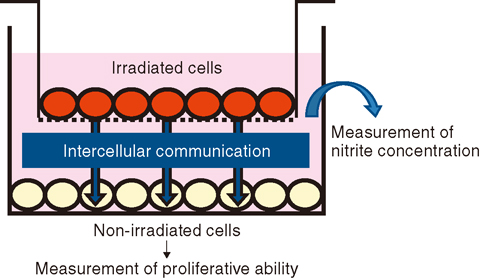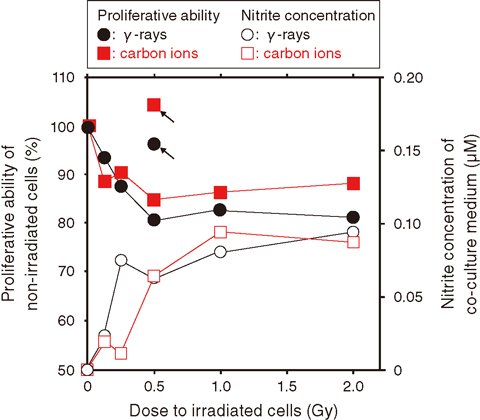
Fig.5-26 Detection of bystander effect

Fig.5-27 Decrease in the proliferative abilities of non-irradiated cells and increase in nitrite concentrations in the co-culture medium
The bystander effect refers to the phenomenon whereby non-irradiated cells close to irradiated ones mimic the same radiation effects due to intercellular communication.
In this study, we irradiated normal human lung fibroblast WI-38 cells with γ-rays or a carbon ion beam at the Takasaki Advanced Radiation Research Institute, co-cultured the irradiated cells with non-irradiated cells, and measured the proliferative abilities of the non-irradiated cells (Fig.5-26).
As a result, we found that the proliferative abilities of non-irradiated cells decreased in dose-dependent and radiation quality-independent manners (Fig.5-27). The proliferative abilities of non-irradiated cells, however, did not decrease when NO radicals were scavenged from the co-culture medium using the specific scavenger 2-(4-Carboxyphenyl)-4,4,5,5-tetramethylimidazoline-1-oxyl-3-oxide (carboxy-PTIO), indicating that NO radicals are necessary for the induction of the bystander effect. We thus measured the concentrations of nitrite, derived from biosynthesized NO radicals, in the co-culture medium to partly elucidate the molecular mechanism of the bystander effect (Fig.5-26). There was a negative relation between the increase in the concentration of nitrite and the decrease in the proliferative abilities of non-irradiated cells (Fig.5-27). It is assumed that stress-responsive transcription factors such as the nuclear factor κB and downstream NO synthase may have been activated.
Recently, heavy ion radiotherapy has been considered as a minimally invasive form of radiotherapy because of its intensive energy deposition in the tumor region. Undesirable exposure to the normal tissue between the skin and tumor is, however, inevitable, even in the case of heavy ion radiotherapy. Our findings partly elucidated the molecular mechanism of the bystander effect that may modify this adverse effect. In the future, development of new drugs effective in scavenging NO radicals or suppressing their biosynthesis is expected for reduction of the adverse effects of cancer radiotherapy.
The present study was partly supported by Japan Society for the Promotion of Science (JSPS) KAKENHI Grant-in-Aid for Young Scientists (B) (No.25740019).